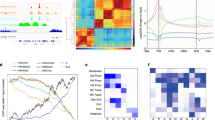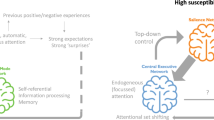Abstract
We examined epigenetic regulation in regards to behaviorally and clinically relevant human brain function. Specifically, we found that increased promoter methylation of the serotonin transporter gene predicted increased threat-related amygdala reactivity and decreased mRNA expression in postmortem amygdala tissue. These patterns were independent of functional genetic variation in the same region. Furthermore, the association with amygdala reactivity was replicated in a second cohort and was robust to both sampling methods and age.
This is a preview of subscription content, access via your institution
Access options
Subscribe to this journal
Receive 12 print issues and online access
$209.00 per year
only $17.42 per issue
Buy this article
- Purchase on Springer Link
- Instant access to full article PDF
Prices may be subject to local taxes which are calculated during checkout


Similar content being viewed by others
Accession codes
References
Hariri, A.R. Annu. Rev. Neurosci. 32, 225–247 (2009).
Meaney, M.J. & Szyf, M. Dialogues Clin. Neurosci. 7, 103–123 (2005).
Caspi, A., Hariri, A.R., Holmes, A., Uher, R. & Moffitt, T.E. Am. J. Psychiatry 167, 509–527 (2010).
Brenet, F. et al. PLoS ONE 6, e14524 (2011).
Fakra, E. et al. Arch. Gen. Psychiatry 66, 33–40 (2009).
Abercrombie, H.C. et al. Neuroreport 9, 3301–3307 (1998).
Mehta, D. et al. Proc. Natl. Acad. Sci. USA 110, 16044–16049 (2013).
Chaouloff, F. J. Psychopharmacol. 14, 139–151 (2000).
Hariri, A.R. et al. Science 297, 400–403 (2002).
Fisher, P.M. et al. Nat. Neurosci. 9, 1362–1363 (2006).
Baas, D., Aleman, A. & Kahn, R.S. Brain Res. Brain Res. Rev. 45, 96–103 (2004).
Young, E.J. & Williams, C.L. Behav. Neurosci. 124, 633–644 (2010).
Rhodes, R.A. et al. J. Neurosci. 27, 9233–9237 (2007).
Bigos, K.L. et al. Neuropsychopharmacology 33, 3221–3225 (2008).
Di Simplicio, M., Norbury, R., Reinecke, A. & Harmer, C.J. Psychol. Med. 44, 241–252 (2013).
Tylee, D.S., Kawaguchi, D.M. & Glatt, S.J. Am. J. Med. B Neuropsychiatr. Genet. 162B, 595–603 (2013).
Wang, D. et al. PLoS ONE 7, e39501 (2012).
Sheehan, D.V. et al. J. Clin. Psychiatry 59 (suppl. 20), 22–33, quiz 34–57 (1998).
First, M.B., Spitzer, R.L., Gibbon, M. & Williams, J.B.M. Structured Clinical Interview for DSM-IV Axis I Disorders, Research Version, Non-patient Edition (New York State Psychiatric Institute, Biometrics Research Department, New York, 1996).
Sibille, E. et al. Am. J. Psychiatry 166, 1011–1024 (2009).
Glantz, L.A. & Lewis, D.A. Arch. Gen. Psychiatry 54, 943–952 (1997).
Carré, J.M., Hyde, L.W., Neumann, C.S., Viding, E. & Hariri, A.R. Soc. Neurosci. 8, 122–135 (2013).
Viviani, R. Neuroimage 50, 184–189 (2010).
Nikolova, Y.S. & Hariri, A.R. Biol. Mood Anxiety Disord. 2, 19 (2012).
Nikolova, Y.S., Ferrell, R.E., Manuck, S.B. & Hariri, A.R. Neuropsychopharmacology 36, 1940–1947 (2011).
Carré, J.M., Fisher, P.M., Manuck, S.B. & Hariri, A.R. Soc. Cogn. Affect. Neurosci. 7, 213–221 (2012).
Tripp, A. et al. Am. J. Psychiatry 169, 1194–1202 (2012).
Gelernter, J., Kranzler, H. & Cubells, J.F. Hum. Genet. 101, 243–246 (1997).
Nikolova, Y.S., Bogdan, R., Brigidi, B.D. & Hariri, A.R. Biol. Psychiatry 72, 157–163 (2012).
Bernstein, D.P. et al. Child Abuse Negl. 27, 169–190 (2003).
Acknowledgements
We thank B. Brigidi, K. Faig, A. Gorka, S. Jacobson, A. Knodt, B. Williams and K. Sugden for their assistance in DNS data collection and analysis, and J. Hanson for his assistance in figure preparation. The Duke Neurogenetics Study is supported by Duke University and National Institute on Drug Abuse grant DA03369. The Teen Alcohol Outcomes Study was supported by AA016274 and ongoing support from the Dielmann Family (D.E.W.). Y.S.N. receives support through a Howard Hughes Medical Institute International Student Research fellowship. A.R.H. receives support through National Institute on Drug Abuse grants DA033369 and DA031579. K.C.K. receives support through National Institute of Mental Health grants MH078928 and MH093612. E.S. receives support through National Institute of Mental Health grants MH084060 and MH077159.
Author information
Authors and Affiliations
Contributions
Y.S.N. designed the study, participated in the collection of the neuroimaging and genetic data for the discovery cohort, conducted all of the statistical analyses, and wrote the manuscript with A.R.H. K.C.K. and S.G. designed and coordinated the methylation analyses in the discovery cohort. C.-M.W. developed and performed the methylation assays in the replication and postmortem cohorts. M.L.S. conducted the quantitative PCR in the postmortem cohort. E.S. designed the parent protocol, supervised quantitative PCR experiments and coordinated methylation analyses in the postmortem cohort. D.E.W. designed the parent protocol for the replication cohort and coordinated the methylation assays in both the replication and postmortem cohorts. A.R.H. designed the study, coordinated all analyses and wrote the manuscript with Y.S.N. He also designed the parent protocol for the discovery cohort and the neuroimaging protocol for the replication cohort. All of the authors provided feedback on the manuscript and approved its final version.
Corresponding author
Ethics declarations
Competing interests
The authors declare no competing financial interests.
Integrated supplementary information
Supplementary Figure 1 SLC6A4 methylation assay PCR bias testing.
PCR bias testing was performed by EpigenDx separately for the entire ADS580 assay (red line) and CpG 14 (blue line). Data are presented for the 0-100% (a) and 0-10% (b) range.
Supplementary Figure 2 Scatterplots depicting the correlations between PC1 and bilateral amygdala reactivity in the Discovery and Replication cohorts.
The top principal component capturing 24% of the variability in SLC6A4 proximal promoter methylation in the Discovery cohort was positively correlated with left amygdala reactivity (a) and predicted right amygdala reactivity at a trend-level (b). The top principal component capturing 30% of the variability in SLC6A4 proximal promoter methylation in the Replication cohort was positively correlated with left (c), but not right (d) amygdala reactivity. *p < 0.05, #p < 0.10
Supplementary information
Supplementary Text and Figures
Supplementary Figures 1 and 2 and Supplementary Tables 1–6 (PDF 1522 kb)
Supplementary Methods Checklist
(PDF 395 kb)
Rights and permissions
About this article
Cite this article
Nikolova, Y., Koenen, K., Galea, S. et al. Beyond genotype: serotonin transporter epigenetic modification predicts human brain function. Nat Neurosci 17, 1153–1155 (2014). https://doi.org/10.1038/nn.3778
Received:
Accepted:
Published:
Issue Date:
DOI: https://doi.org/10.1038/nn.3778
This article is cited by
-
Reactivity of the ventromedial prefrontal cortex, but not the amygdala, to negative emotion faces predicts greed personality trait
Behavioral and Brain Functions (2023)
-
5-HTR2B and SLC6A3 as potential molecular targets of sertraline in the treatment of major depressive disorder: the use of bioinformatics and its practical implication
Network Modeling Analysis in Health Informatics and Bioinformatics (2022)
-
Factors related to age at depression onset: the role of SLC6A4 methylation, sex, exposure to stressful life events and personality in a sample of inpatients suffering from major depression
BMC Psychiatry (2021)
-
Variability in DNA methylation at the serotonin transporter gene promoter: epigenetic mechanism or cell-type artifact?
Molecular Psychiatry (2020)
-
Serotonin transporter promoter methylation in peripheral cells and neural responses to negative stimuli: A study of adolescent monozygotic twins
Translational Psychiatry (2018)



